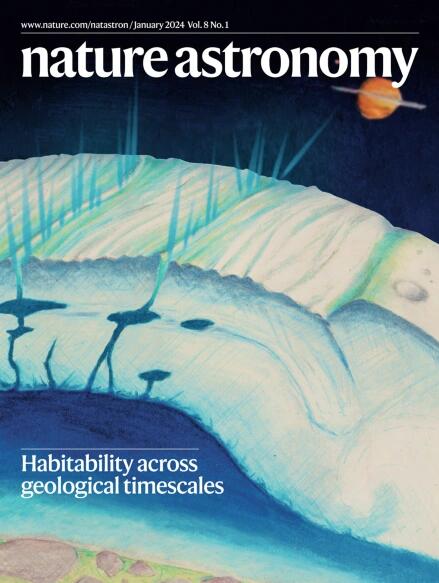由侵蚀和气候模式驱动的古代火星景观的深层化学风化
IF 14.3
1区 物理与天体物理
Q1 ASTRONOMY & ASTROPHYSICS
引用次数: 0
摘要
火星上存在着厚厚的粘土矿物地层(CSs),据信是在火星地质历史早期(37亿年前)在比现在更温暖、更湿润的条件下通过自上而下的淋滤形成的。在地球上,这种沉积物需要特定的景观和气候条件才能形成;然而,尚不清楚火星的局部和全球地形变化以及过去的气候活动如何影响地表风化和CS的形成。在这里,我们提出的观察结果表明,CSs往往发生在化学风化作用比物理侵蚀更有利的地区,远离山谷网络活动,靠近静止的水体。我们的结论是,在这个构造不活跃的行星上,通过增强的化学风化作用,厚碳水化合物的发展可能导致了与地球相比不平衡的天气-气候反馈。我们的研究结果支持了一个假设,即黏土矿物中长期不可逆的水和阳离子封存可能会随着时间的推移抑制水文活动,并可能抑制碳酸盐矿物的形成。本文章由计算机程序翻译,如有差异,请以英文原文为准。


Deep chemical weathering on ancient Mars landscapes driven by erosional and climatic patterns
Across Mars exist thick clay mineral-bearing stratigraphies (CSs), thought to have formed through top-down leaching early in Mars’s geological history (>3.7 billion years ago) under warmer, wetter conditions than at present. On Earth, such deposits require specific landscape and climatic conditions to develop; however, it is unclear how Mars’s local and global topographic variations and past climate activity influenced surface weathering and CS formation. Here we present observations that show that CSs tend to occur in areas where chemical weathering was favoured over physical erosion, farther from valley network activity and nearer standing bodies of water. We conclude that the development of thick CSs through enhanced chemical weathering on this tectonically inactive planet may have led to an imbalanced weathering–climate feedback compared with Earth. Our results support the hypothesis that long-term irreversible sequestration of water and cations within clay minerals may have inhibited hydrological activity, and potentially carbonate mineral formation, over time. New findings reveal how terrain influenced Mars’s early surface evolution, allowing regions of stable chemical weathering to develop and permanently trap water and minerals, weakening Mars’s climate feedback and limiting long-term hydrological activity.
求助全文
通过发布文献求助,成功后即可免费获取论文全文。
去求助
来源期刊

Nature Astronomy
Physics and Astronomy-Astronomy and Astrophysics
CiteScore
19.50
自引率
2.80%
发文量
252
期刊介绍:
Nature Astronomy, the oldest science, has played a significant role in the history of Nature. Throughout the years, pioneering discoveries such as the first quasar, exoplanet, and understanding of spiral nebulae have been reported in the journal. With the introduction of Nature Astronomy, the field now receives expanded coverage, welcoming research in astronomy, astrophysics, and planetary science. The primary objective is to encourage closer collaboration among researchers in these related areas.
Similar to other journals under the Nature brand, Nature Astronomy boasts a devoted team of professional editors, ensuring fairness and rigorous peer-review processes. The journal maintains high standards in copy-editing and production, ensuring timely publication and editorial independence.
In addition to original research, Nature Astronomy publishes a wide range of content, including Comments, Reviews, News and Views, Features, and Correspondence. This diverse collection covers various disciplines within astronomy and includes contributions from a diverse range of voices.
 求助内容:
求助内容: 应助结果提醒方式:
应助结果提醒方式:


